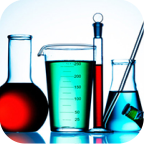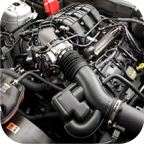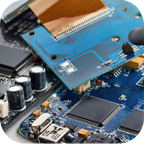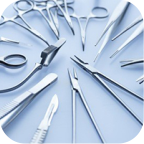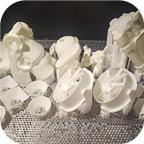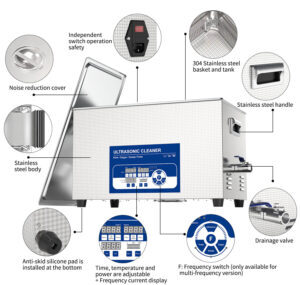What Temperature Should You Use When Ultrasonic Cleaning Parts?
Browse Volume:97 Classify:Support
There’s something quietly fascinating about watching ultrasonic waves do their work—tiny bubbles dancing through a liquid bath, invisible energy lifting away the grime of time. Whether you’re cleaning carburetors, surgical instruments, or 3D-printed components, ultrasonic cleaners offer an elegant, almost meditative solution to an otherwise gritty job. But there’s a question that often bubbles to the surface: how hot should the water be?
At first glance, it might seem intuitive—just crank up the heat to make cleaning faster. After all, heat helps loosen dirt and grease. But ultrasonic cleaning isn’t a basic soak in warm water. It’s a delicate symphony of sound waves, fluid dynamics, chemistry, and thermal balance. And the temperature you choose isn’t just a footnote in the process—it can make or break your cleaning performance, equipment life, and even the integrity of the parts you’re trying to preserve.
So, how do you navigate the nuance of temperature control in ultrasonic cleaning? Why does it matter so much? And what should you know if you’re looking to strike the right balance between too cold to be effective and too hot to be safe?
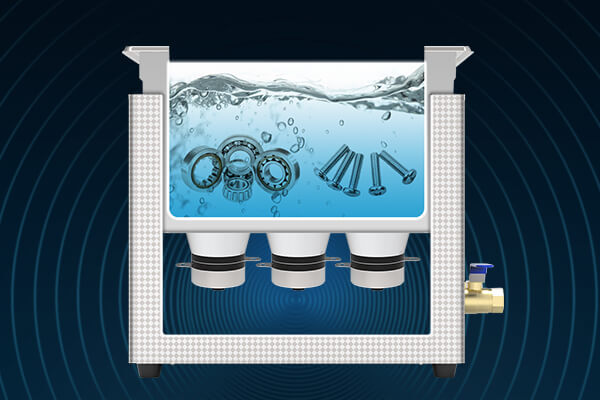
Ultrasonic cleaning
Let’s start by looking at what temperature actually does to the cleaning process.
The Role of Temperature in Ultrasonic Cleaning Efficiency
Ultrasonic cleaning is powered by cavitation—the rapid formation and implosion of microscopic bubbles created by high-frequency sound waves. These implosions generate localized pressure and heat, dislodging contaminants from the surface of submerged items. But cavitation doesn’t exist in a vacuum—it is profoundly influenced by the temperature of the liquid in the tank.
Water at room temperature can still cavitate, but the process is sluggish. Cold liquid dampens bubble activity, reducing the intensity of the cleaning action. On the other hand, increasing the temperature speeds up the movement of molecules, lowers the surface tension of the liquid, and makes contaminants easier to dislodge. Warmer solutions also help dissolve oils and greases more effectively, acting like a catalyst to the chemical part of the cleaning equation.
However, the relationship between temperature and cavitation isn’t linear. If you push the temperature too high—usually above 80 degrees Celsius—the liquid becomes so energetic that cavitation bubbles form too quickly and collapse too softly. You get heat, but not cleaning power. Worse, excessive heat can damage sensitive parts, denature certain cleaning solutions, and shorten the lifespan of transducers.
That’s why most ultrasonic cleaning systems recommend a working range between 40 and 60 degrees Celsius. Within this band, you typically get strong cavitation activity, faster soil breakdown, and better emulsification of oils—without introducing the risks associated with overheating.
Matching Temperature to Material and Contaminant Type
Not all parts respond the same way to heat. A carburetor caked in oxidized fuel deposits will thrive under entirely different conditions than a delicate aluminum watch case or a precision-etched silicon wafer. Temperature, like cleaning chemistry and frequency, must be calibrated based on what you’re cleaning and what you’re trying to remove.
Grease, oil, and wax residues, for example, respond best to elevated temperatures. Many oils begin to break down around 50 to 60 degrees Celsius, and at those temperatures, ultrasonic agitation helps emulsify the oils so they can be suspended and carried away by the fluid. For automotive parts, valves, and mechanical components with embedded grime, starting at 55 degrees and increasing as needed (up to 70°C in industrial scenarios) tends to yield reliable results.
Carbon buildup and oxidation, such as those found on engine parts or burned electronics, benefit from a mix of moderate heat (50 to 60°C), aggressive cleaning chemistry (alkaline cleaners), and time. Too much heat can actually re-bake these residues or accelerate corrosion on metals like brass, so a measured approach is critical.
Plastic and rubber parts tend to deform or degrade above 60 degrees Celsius. If you’re cleaning delicate retainers, eyeglass components, or rubberized grips, it’s safer to remain within the 30 to 45°C range. This ensures effective cleaning without risking warping, discoloration, or structural fatigue.
Soft metals like aluminum or brass also have temperature sensitivities. While they handle 50°C well, excessive heat combined with aggressive cleaning agents can result in etching or surface dulling. For these, staying below 55°C while using a pH-neutral or mildly alkaline solution is safer.
Delicate electronics and PCBs (printed circuit boards), when properly sealed or selectively immersed, generally perform best under 40 to 50°C. High temperatures can damage coatings or warp fine solder joints. Cleaning should always be followed by a thorough drying process to prevent moisture retention.
Temperature isn’t just a preference—it becomes a protective barrier or a performance enhancer depending on the context. Just as overcooking ruins a fine steak, overheating a part during ultrasonic cleaning can lead to microscopic surface damage, distorted tolerances, or even dissolved finishes. That’s why in critical industries, temperature logs are maintained just as religiously as cleaning solution concentrations or exposure durations.
How Temperature Influences Cleaning Chemistry
Cleaning solutions used in ultrasonic systems aren’t passive participants—they’re active chemical agents that work synergistically with temperature and cavitation. The wrong temperature can dull or destabilize the solution’s performance, while the right temperature activates it like a catalyst, enhancing cleaning efficiency and consistency.
Most aqueous alkaline cleaners, the kind commonly used for degreasing metal parts, function best between 50°C and 65°C. At this temperature range, the saponification of fats and oils is more efficient, allowing grease to break down into smaller, emulsifiable components. The heat reduces the solution’s surface tension, making it easier for cavitation bubbles to form and collapse closer to the part surface, thus delivering more intense microscopic scrubbing.
However, enzymatic solutions, which are occasionally used for organic material removal (such as in dental and medical device cleaning), are highly temperature-sensitive. These enzymes often degrade rapidly above 45°C, meaning their optimal cleaning range is much lower—around 30°C to 40°C. Going above that can kill their activity, making them ineffective no matter how long you run the ultrasonic cycle.
Then there’s the case of acidic or descaling cleaners, which are used to remove rust, limescale, or mineral deposits. These cleaners can become corrosive at elevated temperatures if left unchecked. While they are often used at 50°C or above, you must be cautious with the immersion time and the material being cleaned. For example, zinc and galvanized coatings can be etched or stripped if combined with strong acids and high heat.
Neutral pH cleaners, which are safer for softer metals and mixed-material assemblies, typically operate best in the 40–50°C range. They rely more on surfactant-based mechanisms than chemical reactions, so the cavitation intensity and temperature together must carry the cleaning load.
What’s worth emphasizing here is that each cleaning agent comes with a manufacturer-recommended temperature range—and those guidelines aren’t just suggestions. Cleaning too cold might leave residues untouched, while cleaning too hot could degrade the chemical, damage the parts, or even risk user safety through vaporization or reactions.
Temperature Strategies Across Different Industries
Ultrasonic cleaning isn’t a one-size-fits-all operation. Industries working with vastly different materials, tolerances, and cleanliness standards must carefully tune their ultrasonic systems—especially when it comes to temperature.
Medical and Dental Fields: Balancing Sterility with Material Sensitivity
In the medical world, cleanliness isn’t just about appearances—it’s about preventing infection, ensuring biocompatibility, and meeting rigorous sterilization protocols. Instruments such as forceps, dental drills, and endoscopic tools are commonly cleaned ultrasonically before sterilization.
The preferred temperature range here is typically 35°C to 45°C. This range supports enzymatic or neutral pH cleaning solutions that break down organic residues (blood, tissue proteins, biofilm) without damaging delicate coatings, plastic parts, or joints. Going above this temperature could denature enzymatic cleaners or risk warping plastic components.
Furthermore, facilities often use multi-stage ultrasonic systems, starting with a lower-temperature enzymatic bath followed by a higher-temperature rinse or disinfection stage. This tiered approach helps preserve instrument life while ensuring microbial safety.
Automotive and Mechanical Workshops: High Heat for Grease and Carbon
Automotive parts, such as carburetors, injectors, gears, and engine blocks, are often coated in stubborn contaminants like motor oil, carbon, metal filings, and gasket material. For these kinds of jobs, higher temperatures in the 60°C to 80°C range are standard.
This high heat assists in melting or loosening grease and oils, allowing the cavitation bubbles to more effectively detach contaminants from complex geometries. The elevated temperature also ensures that the alkaline detergents typically used for degreasing can work at their peak.
However, there are limitations. Rubber seals, plastic gaskets, or delicate electrical connectors may degrade or deform under high temperatures, so technicians often remove these components or reduce temperature accordingly for hybrid cleaning jobs.
Electronics Industry: Precision, Not Power
When cleaning items like printed circuit boards (PCBs), temperature sensitivity is paramount. Excessive heat can warp plastic housings, delaminate board layers, or accelerate corrosion of metal traces. That’s why ultrasonic cleaning for electronics is usually done between 30°C and 40°C—just enough to enhance cleaning solution performance without risking the components.
Electronics also require non-ionic or neutral detergents that don’t leave conductive residues. These solutions benefit from modest heating to reduce surface tension and promote wetting in narrow gaps, but cavitation remains the star of the show. Operators often pair ultrasonic cleaning with vacuum drying to prevent water spots and accelerate turnaround times.
Aerospace and Defense: Tight Tolerances, No Contaminants Allowed
In aerospace, even microscopic residues can compromise flight safety. Ultrasonic cleaning is used for turbine blades, hydraulic components, fuel system parts, and other mission-critical assemblies. Here, temperature decisions are more nuanced.
Alkaline cleaners are used for aluminum and titanium, with temperatures in the 50°C to 65°C range, while acid-based descalers are applied at slightly lower temperatures to avoid metal fatigue or hydrogen embrittlement. Cleaning protocols are often qualified with precise documentation, and deviations can void certifications.
The aerospace industry also increasingly uses automated systems with feedback-controlled heating, ensuring the cleaning solution never exceeds the temperature tolerance for the part being treated. When precision is everything, consistent thermal management becomes just as important as ultrasonic frequency or cleaning time.
Jewelry Industry: Beauty Meets Chemistry
Jewelry cleaning is one of the most publicly familiar uses of ultrasonic systems. For metals like gold, silver, or platinum, ultrasonic cleaning at 50°C to 60°C with mildly alkaline solutions is very effective in removing body oils, lotions, and tarnish.
However, gemstones complicate things. Porous stones like turquoise, opal, pearl, and amber can crack or absorb cleaning fluid at high temperatures, leading to internal damage. These require lower temperatures (under 40°C) and short cycles—or should be cleaned manually. On the other hand, harder gems like diamonds or sapphires can handle hotter baths and longer exposures.
Jewelry professionals often keep two temperature presets for their ultrasonic units—one for metal-only pieces and another for mixed-material or stone-inlaid items. That flexibility is critical for balancing cleaning power with preservation.
Common Mistakes When Choosing Temperature for Ultrasonic Cleaning
Even though ultrasonic cleaning machines often look “plug-and-play,” subtle misjudgments in temperature management can result in everything from underperformance to irreversible damage. Understanding these pitfalls is key to ensuring both safe and effective cleaning.
Overheating the Solution
The logic seems sound: hotter water should clean faster, right? While heat does enhance the chemical activity of most detergents and improves cavitation in many situations, there’s a ceiling beyond which you’re doing more harm than good.
For example, temperatures above 80°C can cause certain cleaning solutions to degrade rapidly, releasing vapors, leaving residues, or causing foaming. This not only shortens the lifespan of the cleaning fluid but also risks damaging sensitive materials—such as plastics, soft metals, adhesives, or seals.
Moreover, overheating reduces cavitation intensity. As temperatures approach the boiling point, cavitation bubbles become less forceful because vapor forms more easily but collapses less violently—this paradoxically weakens the cleaning effect even though everything feels hotter.
Ignoring the Warm-Up Phase
A surprising number of users start their cleaning cycle the moment they hear the hum of the machine, without giving the fluid time to reach the target temperature. But ultrasonic cleaning is not just about motion—temperature significantly influences detergent action and bubble dynamics.
Starting before the solution reaches the appropriate temperature leads to inconsistent results. Oils and greases may only partially emulsify. Organic residues might cling on. Worse still, the system might need a longer cycle to compensate, which adds wear on the machine and wastes energy.
The correct process is to heat first, stir or degas if necessary, then insert the parts and begin the ultrasonic cycle.
Using Non-Compatible Solutions with Heat
Not all cleaning solutions are safe to use when heated. Alcohols, acetone, and some volatile organics are flammable or hazardous when vaporized. Even non-flammable solutions might release harmful fumes when heated above their recommended ranges.
When used in a non-ventilated ultrasonic tank with a heater on, these solutions pose a real safety risk—both from inhalation exposure and fire hazard. That’s why most manufacturers explicitly warn against using these fluids in heated cycles and recommend water-based alternatives instead.
Professional guidance from SDS (Safety Data Sheets) or the chemical manufacturer should always be consulted before heating any custom cleaning fluid.
Overlooking the Role of Load Mass
Did you know that inserting a large metal object into a hot ultrasonic tank can drastically drop the temperature? Metal has high thermal conductivity, so a cold object absorbs heat rapidly from the fluid. This is often overlooked by casual users, especially when doing batch cleaning.
If your tank is properly preheated but your items are cold, you’ll lose 5–10°C in the first few minutes—potentially dropping below the solution’s effective cleaning range.
For high-precision jobs, professionals pre-warm parts in a separate chamber or allow the ultrasonic bath to stabilize after part insertion before starting the ultrasonic cycle.
Assuming “Hotter is Always Better” Across All Materials
One of the most common misbeliefs is that temperature upgrades are universally beneficial. While it’s true that many detergents work better warm, some materials simply cannot handle the heat—regardless of the cleaning chemistry.
Here are some examples of materials that are temperature-sensitive:
- Soft plastics or 3D-printed resin parts: Prone to warping or melting above 50°C
- Certain optical components: High heat can destroy surface coatings or disrupt glue bonds
- Natural materials: Like wood, bone, shell, or coral, which may crack or become brittle
- Delicate solder joints or aged PCBs: Especially susceptible to delamination or solder flow
It’s always wise to check the material’s tolerance and test at lower temperatures first, especially if you’re not following a pre-established cleaning protocol.
How to Accurately Measure and Control Temperature in an Ultrasonic Cleaner
For all the emphasis placed on ultrasonic frequency, power, and detergent type, temperature is just as critical—and just as easy to get wrong. Especially in applications where precise outcomes matter (think: aerospace components, dental instruments, circuit boards), knowing and controlling your bath temperature is non-negotiable.
Built-In Heaters Are Often Misleading
Most tabletop and industrial ultrasonic cleaners come with built-in digital heaters and thermostats. These allow you to set a target temperature—say, 50°C—and the unit will aim to heat the solution to that level.
But here’s a little-known fact: these sensors often measure the temperature at the base or side wall of the tank, not the fluid in the center, and certainly not the temperature surrounding your parts.
As a result, your tank may display 50°C, while the solution around your parts is 42°C—or higher if you’ve just inserted warm components. It’s especially misleading if you’re working with large-volume baths, unevenly loaded tanks, or high surface-area parts.
Use an Independent Thermometer for Precision
Professionals often use external digital thermometers, thermocouples, or infrared thermometers to double-check the solution’s actual temperature at various depths.
For example:
- A digital probe thermometer inserted into the center of the bath gives the most reliable real-time reading.
- An infrared thermometer (pointed at the fluid surface) offers quick checks, but may underread if the surface is cooler than the lower layers.
Want to really optimize performance? Measure the solution at rest, after cavitation stops, to get a truer reading—cavitation itself can introduce small heat fluctuations.
Don’t Forget About Passive Heat from Ultrasonics
Even if you don’t use a built-in heater, the ultrasonic transducers themselves produce heat during operation. This means that even “room-temperature” ultrasonic cleaning baths can reach 30–40°C after 15–30 minutes of continuous use.
If you’re dealing with sensitive items that should never be exposed to elevated temperatures—like certain adhesives, shell inlays, or organic substrates—you’ll need to actively monitor and possibly cool the bath.
Some solutions:
- Use ice packs or water jackets on the outside of the tank
- Replace fluid regularly during batch runs
- Turn off ultrasonics periodically to allow the bath to cool
It’s a balancing act, but knowing how much “passive heating” your unit creates over time helps you schedule your clean cycles more effectively.
Stirring and Circulation Improve Temperature Uniformity
One underappreciated trick for improving ultrasonic cleaning results is stirring the solution gently between cleaning cycles, especially in larger tanks. This evens out hotspots and eliminates temperature gradients caused by uneven ultrasonic distribution.
Some industrial systems use circulating pumps that filter and redistribute the liquid while maintaining uniform temperature. If you’re using a benchtop cleaner, you can simply agitate the basket or stir the liquid with a plastic or glass rod before each batch.
Just be sure to pause the ultrasonic function when doing this—you don’t want to interfere with active cavitation.
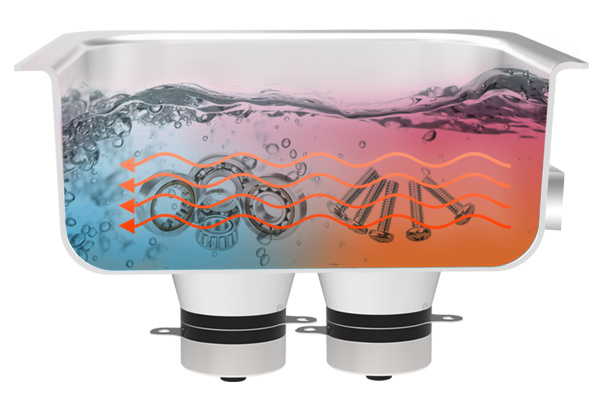
Ultrasonic Cleaner Heating
Ideal Temperature Ranges for Common Parts and Contaminants
When people ask, “What’s the best temperature for ultrasonic cleaning?” they often expect a single number. But the reality is that temperature depends on three intersecting factors:
- The material of the item you’re cleaning
- The type of contaminant you’re removing
- The chemistry of the cleaning solution you’re using
With those in mind, here’s a breakdown of effective ranges that balance performance with material safety.
Jewelry and Delicate Items (Gold, Silver, Gemstones)
For common jewelry, especially gold and silver, a temperature range of 40°C to 50°C works well. This helps loosen oils, soaps, and skin residues while preserving delicate finishes.
However, for organic gemstones like opals, pearls, or turquoise—which can be heat-sensitive—stick to ambient temperatures or below 30°C. These materials may crack or discolor when exposed to prolonged heat or aggressive cavitation.
If you’re using a mild alkaline cleaner (pH 8 to 10), this range also maximizes cleaning action without attacking metal finishes or glue joints.
Dental Tools and Surgical Instruments
Medical tools are often cleaned using enzymatic or enzymatic-alkaline blends. These agents work best between 45°C and 60°C, where proteins (like blood or tissue residue) denature and detach more easily.
Many hospitals standardize around 50°C for ultrasonic pre-cleaning prior to sterilization, based on infection control guidelines published in journals like Journal of Hospital Infection.
Be careful not to exceed 60°C, though, especially with complex plastic handles or heat-sensitive polymers used in composite tools.
Engine Parts and Oily Components
Here, heat is your ally. For heavy-duty contaminants like carbon, grease, and burnt oil, go hot—often 60°C to 80°C, depending on the cleaner formula.
Industrial-grade degreasers and emulsifying agents often activate more efficiently at higher temperatures. And since metal engine parts like aluminum or steel are highly heat-tolerant, you have more flexibility.
Just be cautious with parts that have seals, gaskets, or composite layers. These materials may degrade or swell under prolonged exposure to high temperatures.
Electronics and PCB Boards
This category demands extra care. While ultrasonic cleaning is used in the electronics industry for solder flux removal or maintenance, it’s vital to stay within 30°C to 40°C.
Why? Higher temperatures increase the risk of trapping moisture in small gaps, or loosening adhesives and insulating materials. Always use distilled water and an electronics-safe surfactant, and dry thoroughly afterward using warm air or vacuum drying.
Low-foaming, low-conductivity fluids are essential here—and heating should be gradual and closely monitored.
Optical Components (Lenses, Glassware)
For lenses, optical filters, or scientific glassware, a moderate range of 35°C to 50°C is effective. At this temperature, ultrasonic waves loosen dust, polish residue, and oils without risking heat stress or warping in composite lens structures.
Glass is thermally stable, but adhesives used in multi-element lenses may not be. Always verify manufacturer specs before ultrasonic cleaning any high-precision optics.
Real-World Case Studies: Temperature Choices That Changed the Outcome
Nothing illustrates the importance of temperature in ultrasonic cleaning quite like real-world use cases. Across diverse industries—from aerospace to dentistry—the decisions made around heat settings have either amplified results or compromised them entirely. Let’s walk through a few examples to see how temperature selection in ultrasonic parts cleaning plays out when the stakes are real.
Aerospace: Cleaning Titanium Components at Controlled Heat
In aerospace engineering, titanium and aluminum alloy components often demand meticulous cleaning between machining or prior to coating. At one major MRO (Maintenance, Repair, and Overhaul) facility in Europe, engineers discovered that using ultrasonic cleaning at 70°C caused premature oxidation on aluminum housings. Switching to a controlled 45°C bath, combined with a slightly acidic detergent, not only eliminated the oxidation problem but also improved bond adhesion for subsequent coatings.
The lesson? More heat doesn’t always mean better cleaning—especially when you’re dealing with metals sensitive to oxidation or thermal expansion.
Automotive Restoration: Degreasing Engine Parts at Higher Temperatures
On the opposite end, consider a vintage car restoration shop in the U.S. They clean decades-old engine blocks, pistons, and carburetor components covered in baked-on grease. For them, an 80°C setting paired with a high-alkaline cleaner broke down residues far more effectively than anything done at lower temps. Not only did this save hours of manual scrubbing, but it also avoided the use of harsh solvents.
Cavitation at elevated temperatures loosened carbonized oil and rust without damaging the parts. The shop later reported that parts cleaned at 80°C had better post-clean inspection results and fewer returns from customers.
This example shows how temperature synergizes with detergent chemistry—higher heat activates certain surfactants and emulsifiers, making the ultrasonic action more potent.
Dental Clinics: Cleaning Instruments with Thermal Awareness
Dental clinics frequently rely on ultrasonic baths to clean tools before sterilization. But many don’t realize that temperatures above 60°C can cause protein contaminants to coagulate, making them harder to remove. In a study by the Journal of Dental Sciences, clinics that cleaned at 40°C to 45°C with enzymatic solutions had 20 percent higher debris removal scores than those using higher temperatures.
The key insight? Thermal sensitivity isn’t just about protecting materials—it’s about cleaning effectiveness itself. Proteins, blood, and biofilms respond differently to temperature, especially in medical and dental contexts.
Electronics Manufacturing: PCB Cleaning and Heat Risks
Ultrasonic cleaning of printed circuit boards (PCBs) requires an entirely different mindset. Excess heat can warp plastic connectors, degrade adhesives, or even stress solder joints. A Chinese electronics OEM reported that cleaning at temperatures above 50°C led to increased rates of intermittent PCB failures.
By lowering the bath to 35°C and extending the cleaning time by a few minutes, they avoided thermal stress and maintained cleaning efficacy. This adjustment dramatically reduced returns and warranty claims.
Here, the story shifts from chemical activation to structural integrity—proving that temperature must be tailored not just for cleaning power, but also for long-term product reliability.
Avoiding Common Missteps: What Not to Do
Just as temperature can enhance cleaning, it can just as easily backfire when misapplied. Here are a few scenarios where users often go wrong:
- Cranking up the heat immediately after turning on the cleaner without allowing the fluid to circulate properly. This can create hot spots or thermal gradients that reduce cavitation efficiency.
- Using boiling or near-boiling temperatures in the mistaken belief that hotter is always better. For many materials, especially plastics or bonded items, this is a fast track to damage.
- Ignoring the detergent’s operating range. Each cleaning solution has an optimal temperature window. Exceeding it may denature enzymes or volatilize surfactants.
Cleaning performance is not just a function of cavitation intensity—it’s a dance between physics, chemistry, and heat transfer. The better you understand their interdependence, the more predictable and effective your results will be.
Creating Your Own Ultrasonic Temperature Reference Guide
Given how critical temperature is in ultrasonic cleaning, it’s useful to build a reference matrix you can adapt to your own parts and workflows. Below is a simplified table based on industry research and user experience, highlighting typical temperature ranges for various materials and contaminants:
| Item Type | Contaminant Type | Recommended Temperature Range (°C) | Notes |
|---|---|---|---|
| Aluminum engine parts | Oil, grease, carbon | 55–65 | Avoid going above 65°C to prevent oxidation or etching |
| Steel or iron components | Heavy grease, rust | 65–80 | Works best with alkaline or rust-removing additives |
| Brass or copper fittings | Tarnish, oils | 45–60 | Higher temps may accelerate tarnishing; watch detergent pH |
| Titanium aerospace parts | Machining residue | 40–50 | Lower heat preserves structural integrity and prevents oxidation |
| Surgical/dental instruments | Blood, proteins | 35–45 | Enzymatic cleaners work best in this range |
| Plastic components | Dust, oils | 30–40 | Avoid distortion or warping |
| Jewelry with stones | Skin oil, lotion, dust | 40–50 | Softer stones require lower temperatures |
| PCBs (circuit boards) | Flux, dust, residues | 30–45 | Heat can damage adhesives and coatings |
| Retainers, dentures | Plaque, saliva | 35–45 | Too much heat may deform shape or affect embedded wires |
This chart is a guideline—not a rulebook. Always defer to manufacturer documentation, particularly when cleaning delicate or expensive items. And if you’re ever unsure, start on the lower end of the temperature range and observe the results before adjusting upward.
Final Takeaway: Temperature is Not Just a Number—It’s a Strategy
Choosing the right ultrasonic cleaning temperature isn’t a matter of trial and error or copying what others use. It’s a strategic decision that considers:
- The material composition of your parts
- The type and thickness of contamination
- The chemistry of your cleaning solution
- The geometry and fragility of your items
- And most importantly, the desired result
When all these elements are aligned, temperature becomes more than just a number on your cleaner’s control panel—it becomes a lever of precision. Whether you’re a watchmaker, a biomedical technician, a car restorer, or an electronics manufacturer, understanding how heat amplifies or mitigates cavitation gives you more control, fewer surprises, and consistently better outcomes.
By treating temperature as a dynamic variable—rather than a fixed default—you make your ultrasonic cleaning process not only more effective but also safer, more repeatable, and ultimately more professional.
 Granbo Sonic
Granbo Sonic




